Adventure On Film: Paperhouse
By and large, if I had to drop one decade from the annals of cinema, it would be the eighties,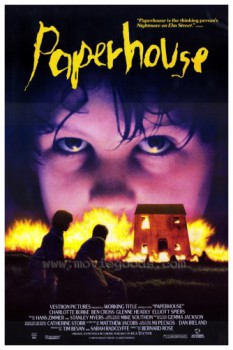 but that period did come up with its share of winners.
but that period did come up with its share of winners.
One of the eighties’ forgotten gems is the fantasy-horror hybrid, Paperhouse (1988), a British release that did its best to compete with flicks like Heathers for Cineplex space, and failed. U.S. gross, according to the internet movie database, was just over $241 thousand. Sad. Paperhouse deserved better, much better.
Spoiler-free, the plot follows Brit tween Anna, curious about lipstick but not yet ready for boys, as she succumbs to a severe case of glandular fever. The disease leaves her prone to vivid dreams, all of which stem from Anna’s crayon drawing of a bleak, lonely house. Whatever Anna adds to the house manifests itself in her dreams, and what starts out as a bit of a lark (think Harold and the Purple Crayon) quickly turns sour. Hardly twenty minutes in and it becomes clear that Anna may well have planted (or drawn) the seeds of her own destruction.
Having just read Violette Malan’s piece on John Gardner (On Moral Fiction) right here at Black Gate not a week before sitting down to re-watch Paperhouse, I couldn’t help but be struck by the film’s parallels to Gardner’s own arguments in favor of “moral” art and criticism. But what Gardner posits in his book he pursues by Socratic argument, in essay form; Paperhouse cleverly crafts those same questions into a cohesive dramatic whole.
Yes, the movie can be enjoyed on a purely surface level, without ever ceding the floor to philosophy, but make no mistake, this little chiller has a great deal more on its mind than things that go bump in the night, which is why it holds up so well, twenty-five years on.
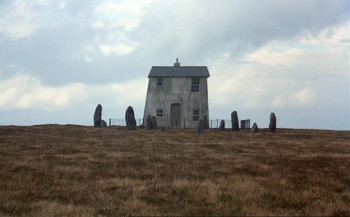 Aside from the horror trappings — sudden movements, creaking doors, shadowy figures stalking closer and armed with hammers — Paperhouse asks the sneaky, diabolical question, does bad art lead to bad outcomes?
Aside from the horror trappings — sudden movements, creaking doors, shadowy figures stalking closer and armed with hammers — Paperhouse asks the sneaky, diabolical question, does bad art lead to bad outcomes?
When Anna draws something pleasant, like a bicycle, she gets it (more or less), but when she adds a frown to a figure in her drawing, she gets that, too: a character in her dream who is morose or furious, depending.
Worse luck for her, Anna’s eraser won’t function, so her only course is to “draw better” — in essence, to make better art.
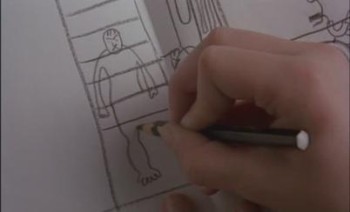 Art for Paperhouse, even simple pencil drawings by an ill little girl, is vital stuff with significant consequences. Just as Anna can save her dream-self through her art (and save, too, her dream-companion, a crippled boy named Marc), art is the beacon that might save or at least salvage wakeful, real-world Anna.
Art for Paperhouse, even simple pencil drawings by an ill little girl, is vital stuff with significant consequences. Just as Anna can save her dream-self through her art (and save, too, her dream-companion, a crippled boy named Marc), art is the beacon that might save or at least salvage wakeful, real-world Anna.
By keeping its dramatic focus squarely on Anna, and by making it increasingly clear that her fever could kill, Paperhouse drives home one emotional stake after another.
Anna’s plight resonates because she’s in danger not in one world but in two, simultaneously, and either one could prove lethal.
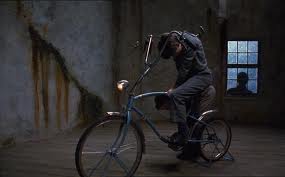 The film’s secret weapon stems from art of another order, music. Stanley Myers and Hans Zimmer collaborated to create the score, a fabulously effective blend of Bernard Hermann-style shocks, rich symphonic swells, and nervy electronica that recalls Tangerine Dream. All three blend seamlessly with two movements lifted from one of the classical canon’s most gorgeous works, Faure’s Requiem, used here to heart-wrenching effect.
The film’s secret weapon stems from art of another order, music. Stanley Myers and Hans Zimmer collaborated to create the score, a fabulously effective blend of Bernard Hermann-style shocks, rich symphonic swells, and nervy electronica that recalls Tangerine Dream. All three blend seamlessly with two movements lifted from one of the classical canon’s most gorgeous works, Faure’s Requiem, used here to heart-wrenching effect.
Charlotte Burke, who played Anna, never made another film. Co-star Elliot Spiers, playing Marc, died young. Director Bernard Rose has struggled to find a hit, despite moderate successes like Candyman (1992) and Immortal Beloved (1994).
In 2013, he released The Devil’s Violinist, which so far as this writer can tell, went straight to DVD in the U.S.
Paperhouse, then, stands as regrettable proof that the cream does not always rise to the top. In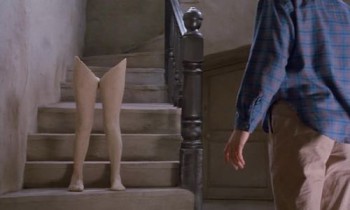 fact, Paperhouse is now so obscure that I was unable to obtain it through Netflix or my (excellent) local library.
fact, Paperhouse is now so obscure that I was unable to obtain it through Netflix or my (excellent) local library.
I could order it from Amazon, yes, but with the quaint proviso that I’ll accept it on VHS! The advent of DVDs is now some twenty-plus years in the past, yet Paperhouse remains adrift on the sidelines. (Weirdly, this echoes the film’s debatable but unquestionably emotional climax.)
In the end, I was forced to screen Paperhouse on the pixilated paradise of Youtube. As Edmund O’Brien says in The Wild Bunch, “It ain’t like it used to be, but it’ll do.”
‘Til next time.
Onward.
Mark Rigney has published three stories in the Black Gate Online Fiction library: ”The Trade,” “The Find,” and “The Keystone.” Tangent called the tales “Reminiscent of the old sword & sorcery classics… once I started reading, I couldn’t stop. I highly recommend the complete trilogy.” In other work, Rigney is the author of ”The Skates,” and its haunted sequels, “Sleeping Bear” and Check-Out Time, forthcoming in 2014.
I’ve never seen the film, but I read the book on which it was based ‘Marianne Dreams’. I’d heartily recommend it. In the book, Marianne’s ‘mistakes’ – the alterations that have negative outcomes – are sometimes due to her negative mood. So maybe there is a moral dimension (?). The stones surrounding the house each end up with a single, malevolent eye – which I thought was a nice touch. I wonder if they do in the film?
I came across this book via a curious route. I used to be a big ‘Lost’ fan, partially because the series constantly referenced books in relation to particular characters: if you picked up the reference, then you had some idea as to the plot direction of that particular character. There were two characters Bernard and Rose. I googled ‘Bernard Rose’* saw he’d directed ‘Paperchase’, had a vague memory of the book on which it was based, and bought it.
* interestingly, there did seem to be quite a few corollaries between the plot of ‘Lost’ and ‘The Dark Crystal’ (the first film Rose worked on) and I guess also with ‘Paperhouse’ (two people, both seriously ill, share a house created by one of them) but none of them solid enough to warrant further investigation. In any event, I’m guessing quite a few plotlines were abandoned due to the writers’ strike.
Aonghus, I love the backstory on how you came to find this title. I’ll be sharing something similar in a few weeks, in a posting on LITTLE, BIG.
I don’t recall an eye being featured in the film, single, malevolent, or otherwise, but I might have looked past it, thinking it was the sun. Tricky to remember: not only was I fighting Youtube’s pixels, but it’s now been several months since I saw the film. (Blogging in my life has nothing to do with “real” time.)
Funnily enough I’ve never read ‘Little, Big’! – although I read ‘Aegypt’ which I really enjoyed at the time.
I saw Paperhouse when it was first in the theaters, and while I liked the overall feel of it, I wasn’t as big a fan as you. Nothing wrong with that, of course, and at least you like an *interesting* film.
I definitely wouldn’t want to give up the decade of the 80s though. For me, just about any decade before that. Just about every big film of the 70s I’m just “eh” about: Jaws (eh), Rocky (eh), Saturday Night Fever (eh), Godfather (OK, I’ll give you that one), Star Wars (OK, that one too 😉 ), Alien (uh, OK, I wouldn’t want to give up the 70s either).
But the 80s had a bunch of still favorites: Buckaroo Banzai, Robocop, Aliens, Labyrinth, Back to the Future, Ghostbusters, Night of the Comet, Terminator, and probably quite a few more I’m forgetting. Many would probably include The Princess Bride, but I saw that in the theaters too, and was “eh”. Given how many people love it, I tried it again recently and was still “eh”. And there was A Christmas Story too, although I still go along with the early reviews of it which were largely negative (a film–unlike Paperhouse–which is quite the opposite of interesting).
I did wonder if anyone would pick up the thrown gauntlet of which film decade to hurl into the briny deep. For me, the films that stand out in the seventies are not the blockbusters (although I do admire THE GODFATHER). I’m thinking of the dustier, more taut and rugged films, offerings like SERPICO, DOG DAY AFTERNOON, THE LAST PICTURE SHOW, ROBIN AND MARIAN. ONE FLEW OVER THE CUCKOO’S NEST, CHINATOWN. PATTON. AGUIRRE, THE WRATH OF GOD. DAYS OF HEAVEN and BADLANDS. BREAKING AWAY, DON’T LOOK NOW, THE LAST WAVE, THE MAN WHO WOULD BE KING.
Not to mention comedies like THE STING, ANNIE HALL, HOLY GRAIL, and AIRPLANE. If that last one ain’t rugged, I don’t know what is.
: )
At any rate, PAPERHOUSE does the eighties proud, with or without Wesley and the Rodents of Unusual Size.
The Sting was awesome now that you mention it. I don’t think my wife has ever seen it; may have to acquire that one to show her.
Oh, and back to the 80s, as expected I forgot some, but I can’t believe I forgot Blue Velvet, which for a very long time was my all-time favorite movie (until Babe replace it–quite a different movie, I know–which itself was eventually replaced by Donnie Darko).
And then there’s Full Metal Jacket, my favorite war movie, and another excellent war movie, Platoon, which notably stole the Best Director Oscar from Lynch. 😉
The film’s poster didn’t do it any favors. The images you chose are disturbing enough to appeal to a horror fan, but still poetic and dreamlike enough to draw other kinds of viewers. The poster looks like unadulterated horror. The film as you describe it and show it is one I can’t wait to watch, and would cheerfully pay for. The film as publicized by its studio is one I would have avoided assiduously.
It sounds like Paperhouse may have been an influence on Gaiman’s film Mirrormask, in which a girl just old enough to begin having a romantic life has to venture into a world her drawings created to save her mother — while the dark version of herself she drew escapes and takes over her real life.
Sarah: regarding the poster, agreed. I haven’t read MIRRORMASK, but that does sound like a clear case of literary lineage.
: )